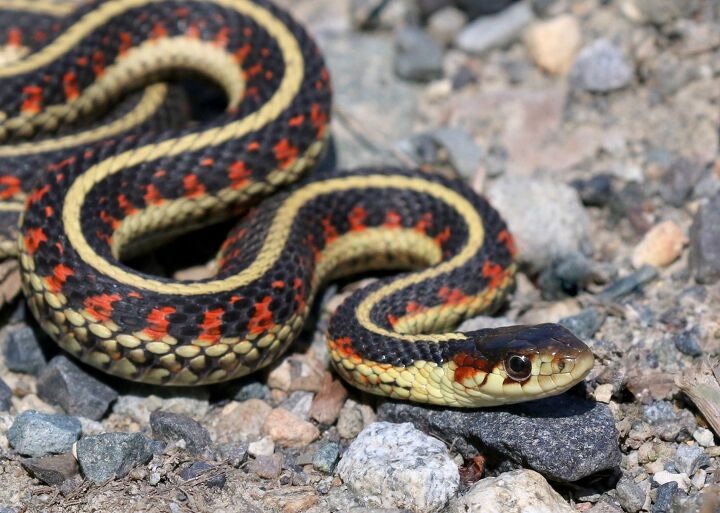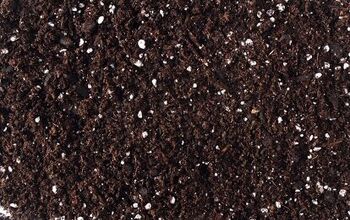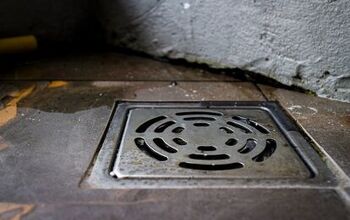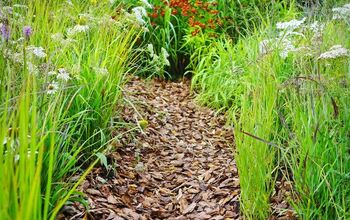What To Do With Snake Holes In The Yard? (Find Out Now!)

Snakes can be scary, especially if you don’t know if they’re venomous or not. If you start to notice snake holes in your yard, take action quickly. Figure out what these holes are, and then do your research to determine the best options for you.
If you have an unoccupied snake hole, you can close it by filling it with dirt or covering it using burlap, netting, or wire. Covering the hole will discourage the snake(s) from returning. However, if the snake hole is occupied, it is best to leave it alone and call a professional for assistance as some snakes may be poisonous.
If you’ve discovered a hole in your yard, you’ve most likely found a snake hole. This guide will help you identify snake holes and tell you what to do if you have a snake living in your backyard.
What Do Snake Holes Look Like?
Snake holes are circular in shape and vary in size. You may see a tiny hole in your grass that has some depth to it or a gaping hole that seemingly came from nowhere. Both of these are most likely snake holes.
Although it is worth noting that other animals such as bunnies, gophers, badgers, and foxes also make holes. So, it’s essential for you to know whether it’s a snake hole or another animal. This will help you know how to go about dealing with it.
How Are Snake Holes Created?
Snake holes are nesting spots for snakes and other animals. While snakes do not build these holes themselves, they make them their home and hide in them. Rodents, gophers, or tortoises usually abandon these holes, and the snakes take up residence.
Snakes cannot dig, but they can slither through loose soil. If you see a snake hole in mulch, another animal most likely dug that hole, and the snake followed. In areas with an abundance of loose sand like Africa, snakes can create these holes by burying themselves in them.
Snakes live in holes because they are a form of safety and comfortability as their backs touch the ceiling. While some snakes are particular when choosing a hole, others will use whatever shelter they can find.
Each snake species prefers a different environment. Cottonmouth species prefer water environments like ponds, streams, ditches, or lakes. In contrast, garter snakes prefer tall grassy, forested areas like tree hollows or under logs.
How Deep Do Snake Holes Go?
Most snakes do not dig; only a few species have the behavior and physiological adaptations required for digging. Instead, most species seek shelter in rat tunnels, rotting tree stump holes, and rock crevices.
Burrowing snakes move only a few inches beneath the surface; they must crawl below the frost line during winter hibernation.
Where Else Can You Find Snake Holes Besides The Grass?
Snake holes can also be seen in larger concrete fractures or trees. Snake holes are frequent around the foundation of your home. Physically seeing a snake lingering in your yard is the easiest way to identify if it is dwelling in a hole or area.
It’s a little more challenging to determine which pest is residing in the holes in your yard if you can’t see it. Therefore, it’s essential that you keep an eye out for the telltale signs that it is a snake hole you discovered.
How To Identify Snake Holes
A variety of things, like children or rotten roots, can cause holes in your yard. They could also be the openings to snake burrows, so how do you determine the difference? Usually, snakes inhabit holes that other small mammals have created and then use them as a nesting spots.
Recognize the Habitat
As mentioned before, different snakes like different environments. Observe the environment around your home; then, you can determine the likeliness of a snake hole.
You could have a cottonmouth near if you live in a water-laden environment with drainage ditches or lakes. You could even have garter snakes present if you live in a forested area with hollow trees or logs.
Look for Shed Snake Skins
An obvious way to know if you have a snake hole is to look for shed snakeskin. Most snakes shed their skin once a month. If rocks are present, look near them as snakes like to rub against the rocks to break off their skin. If you spot a snake shedding its skin, leave it alone as it can become very irritated during this process.
Look for Snake Feces
Snake feces can also indicate a snake hole. You can identify snake feces by their diet, as you will find a trace of its prey. It usually consists of insects, small mammals, and smaller reptiles.
What Kind Of Snake Holes Are In My Yard?
The types of snakes that are most likely slithering around your yard are determined by where you live in the United States. Depending on where you live, it’s important to make sure the snake that occupies your yard is harmless and not poisonous.
Therefore, you need to identify the types of snakes that are occupying the snake holes before you decide to take care of them on your own.
Garter Snakes
These non-venomous snakes are among the most common in North American backyards. Garter snakes range in length from 18 to 21 inches and are available in various colors and patterns, including checkered turquoise, striped yellow, black, and brown. Meadows, forests, hillsides, and marshes are typical habitats for them.
Garter snakes may also be seen as beneficial to a homeowner’s garden since they act as “natural pest management” by devouring troublesome insects. Garter Snakes are not dangerous to people; however, some have a mild neurotoxic venom.
Northern Water Snakes
Northern water snakes range in length from 24 to 42 inches. They have a brown and black speckled body and are often seen near bodies of water (though this isn’t always the case).
Northern water snakes typically migrate away from water, searching for hibernation sites, making your garden or lawn an ideal location. Although Northern Water Snakes are not poisonous, they will bite if they feel threatened.
Water Moccasin
It’s critical not to get the non-venomous Northern water snake mixed up with the dangerous Water Moccasin (the Cottonmouth). Although the Northern water snake and the much bigger water moccasin have similar appearances, the Northern water snake is smaller and slenderer.
Common King Snake
Snakes with black and white stripes are abundant in Arizona. These snakes are harmless and can grow between 2 and 6 feet long.
Red Belly Snake
These are the tiniest snakes found in Minnesota. Redbelly snakes are brown or gray with a bright red belly and grow 8 to 10 inches long.
Rat Snake
The black rat snake is the state’s largest snake. These 6-foot-long critters are harmless, yet their penchant for climbing trees might be alarming. Their backs are covered with gleaming black scales, and their bellies are light in color.
How to Deal with Snake Holes
If you happen to stumble upon a snake hole in your yard, there are a few things that you can do on your behalf to either eradicate the problem or leave it alone.
Leave it Alone
If you spot a snake hole in your garden, it’s best to leave it alone. The snake will feed on insects, mice, frogs, and rats in the garden. If the snake is disturbed by humans, it will slither away.
Cover the Hole
Snakes like to stay in holes because they are cool, dark, and private. If you discover snakes around your home, you can block off these holes to discourage them from returning. Cover the holes with boards, wire fencing, or burlap.
There are a few things to keep in mind when covering the holes. Don’t pile the hole so much that you create a new place for them to stay. Also, be cautious because there’s a chance you may encounter the snake.
Call a Professional Exterminator
Call an exterminator if you’re afraid or uncomfortable with snakes being in your yard. Pest control will come out to assess your home and offer the best solutions for your situation. They also give you options to trap the snake or use a snake fence option.
How Do I Cover a Snake Hole in my yard?
Snake holes in the grass can be filled with earth and re-seeded. Covering snake holes with wiring, netting, or burlap, on the other hand, is more effective because it prevents snakes from returning to their nests beneath a structure or porch. Remember to check the area for snakes first and proceed with caution when blocking the snake hole.
On the other hand, a professional is available to help if you’re uncomfortable covering snake holes yourself or can’t seem to get a handle on your snake problem.
How Can I Tell if a Snake Hole is Occupied or Vacant?
If you have snake holes in your backyard and don’t know how long they’ve been there, you’re probably curious as to if there are still snakes occupying them. You can find out if a snake hole is vacant a few different ways:
- Look out for freshly shed snakeskin. This is a prime sign that there’s an animal living in the hole, and that animal is a snake.
- Observe any snake feces. Snake feces are tubular with a dark coloring and white, chalky urine streaks covering some areas. There may be bones and fur within the feces as well. This is another way to determine that a snake is living in the hole.
- Check to see if there are spiderwebs or debris around the hole. If so, then the hole is most likely empty. If not, there may be a snake nearby. This is the best way to identify if a snake hole is empty.
If you want to see the snake for yourself, you’ll probably have to play the waiting game; there aren’t a lot of tips on how to lure a snake out of hiding. Snakes are cautious creatures and won’t emerge from their holes for a trap or snack. Patience is key!
Safety Precautions Around Snake Holes
Before dealing with snakes, make sure you know snake-bite first-aid treatment. When you have snake holes in your lawn, you can take some safety measures to prepare for accidents.
Reduce the Risk of Being Bitten
You ultimately want to reduce the risk of being bitten when around snake holes. To do this, avoid picking up or moving the snake or placing your hands in the snake hole. If you walk through weeds or tall grass, use a long stick to poke the ground as you walk.
If you spot a snake, move back, far enough away from its striking distance. Make sure to wear protective clothing like leather gloves, high boots, and thick pants when walking in wooded areas. If you’re walking at night, bring a flashlight so that you have a clear vision of what’s around you.
What to Do If a Snake Bites You
If a snake bites you, and you know the snake is venomous, call 911 immediately. If you are unsure if it’s venomous, try to remember the color and shape of the snake. If you have this information, it’s easier to treat the bite or administer antivenom if necessary.
It is essential to keep calm and stay still so that the venom will not spread quickly when bitten. The person bitten should lay or sit where the bite level is below the heart. Cover the bite with a clean, dry bandage.
Related Guide

Stacy Randall is a wife, mother, and freelance writer from NOLA that has always had a love for DIY projects, home organization, and making spaces beautiful. Together with her husband, she has been spending the last several years lovingly renovating her grandparent's former home, making it their own and learning a lot about life along the way.
More by Stacy Randall



































